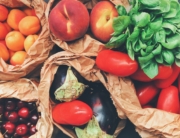Fall has officially knocked on our door with its crisp air and all the goodness that comes with it—can you say pumpkin spiced everything? When I think of Fall, I think of apple picking, the awe-inspiring colors of autumn leaves, snuggling in warm blankets by the fireplace, and of course, hearty whole grains!
Whole grains can be easily incorporated into our daily meals, and the Fall season is a wonderful time to experiment with incorporating more into your diet. Cinnamon sprinkled steel-cut oatmeal with a handful of pecans makes the perfect breakfast to warm our tummies as the weather cools. Or how about some long-grain brown rice as a bed for stir-fried veggies or my personal favorite, Louisiana style red beans and (brown) rice? Whole-wheat blueberry muffins or barley pudding anyone? Autumn can be the perfect time to add some major nutritional benefits to your diet with whole grains.
The USDA recommends that at least half the grains we consume should be “whole”, or about 3 ounces a day. What exactly is the difference between whole grain and refined (think “white” or “enriched” flour)?Grains have three main components: endosperm, bran and germ. Refined flours have been stripped of the nutrient rich bran and germ, and the just the endosperm remains. Whole grains retain their fiber-rich, nutrient-dense composition. This helps you feel full and gives you a steady flow of energy by keeping blood glucose evenly regulated. Refined grains can raise blood glucose more quickly and you may need to eat more to satiate you, or fill you up. Think about those muffins, pizzas, and desserts you can’t seem to get enough of.
Luckily, there are so many ways to enjoy, prepare, and savor whole grain sources of goodness. Look for ‘whole’ related to foods like oats, wheat, and rye and rice—i.e. brown rice, vs. white.
Branch out your whole grain repertoire with items like wild rice, barley, and millet. Intact whole grains (unprocessed into flours and 100% of the original grain kernel) are perfect for soups, stews, in place of hot or cold cereals or great as a topping for salads.
Be sure to read the label and ingredient list of grain based foods like pasta, breads, crackers, and bakery goods: Although you may see the phrases “made with whole grains,” “multi-grain,” or even just “wheat” this does not ensure a 100% whole grain product (or even any whole grain at all!). Items made with enriched and fortified flours are just refined grains that have had the a limited number of the nutrients lost during processing added back in different states and amounts—vitamins like thiamin, and niacin, good-for-you B-vitamins, and protein, antioxidants, and minerals like iron and calcium are depleted. More than 75% of the fiber is removed from this process.
Watching your wallet? Whole grains can be pretty inexpensive too, especially if they are bought in bulk. Cooking whole grains doesn’t have to be complicated either. With a few kitchen tools and time-saving techniques or help from a crock-pot or rice cooker, they actually can be a meal saver. What kind of whole grains will be on your menu today?
Learn more about whole grains in this Today’s Dietitian article that I’m quoted in.









